When it comes to running a business, workplace safety is not just an option—it’s a necessity. But how can small and medium enterprises (SMEs) in the Philippines ensure that their employees are equipped with the right knowledge and skills to maintain a safe working environment? Are safety measures and protocols enough to prevent accidents? The answer lies in basic safety training.
Basic safety training courses play a crucial role in educating employees about potential hazards and teaching them how to minimize risks. By implementing comprehensive safety training programs, SMEs can empower their workforce to make informed decisions that prioritize their own well-being and that of their colleagues. But what exactly does basic safety training entail, and how can it benefit your business?
In this article, we will delve into the importance of workplace safety and explore the various aspects of basic safety training for SMEs in the Philippines. From understanding common occupational hazards to mandatory safety training requirements, we will provide valuable insights and practical tips to help you create a culture of safety within your organization.
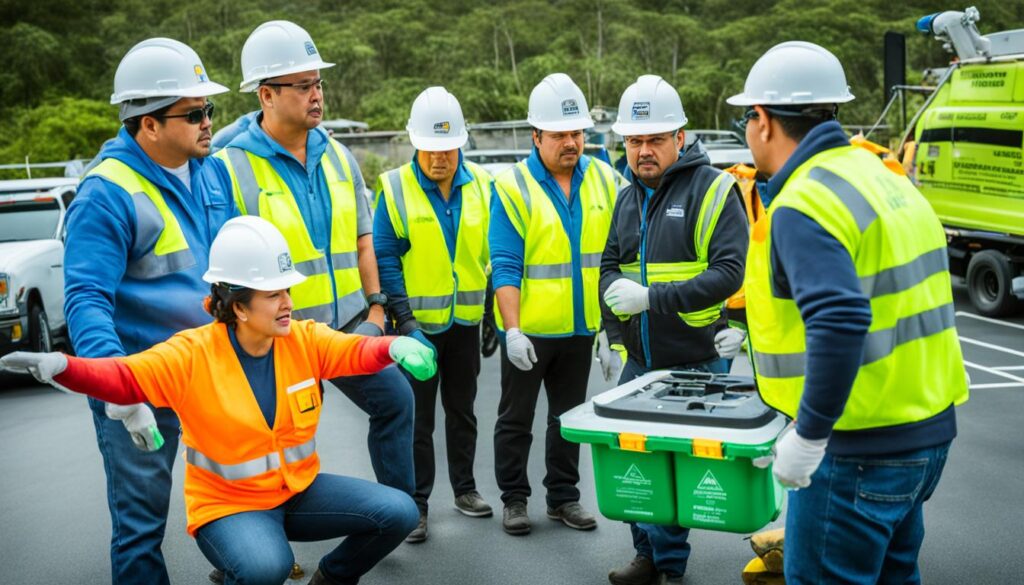
Key Takeaways:
- Basic safety training is essential for SMEs to ensure a safe working environment.
- Safety training courses educate employees about potential hazards and teach them how to minimize risks.
- Implementing comprehensive safety training programs empowers employees to prioritize their own well-being and that of their colleagues.
- Understanding common occupational hazards and complying with mandatory safety training requirements are essential for SMEs in the Philippines.
- Creating a culture of safety within your organization can lead to a more productive and motivated workforce.
The Prevalence of Workplace Accidents in Philippine Industries
Workplace accidents pose significant risks to employees and businesses in various industries in the Philippines. It is crucial to understand the specific hazards and dangers present in different sectors to develop effective strategies for prevention and mitigation. This section explores the prevalence of workplace accidents in Philippine industries and highlights the construction industry risks, manufacturing and agriculture hazards, and mining sector safety concerns.
Construction Industry Risks
The construction industry is notorious for its high rate of workplace accidents and injuries. The nature of construction work involves working at heights, operating heavy machinery, handling hazardous materials, and performing tasks that require precision and coordination. This combination of factors makes construction sites prone to accidents such as falls, electrocution, equipment malfunctions, and structural failures.
Manufacturing and Agriculture Hazards
The manufacturing and agriculture sectors also face significant workplace hazards. In manufacturing, workers may encounter risks associated with operating machinery, exposure to chemicals, and inadequate safety protocols. These hazards contribute to accidents like machinery-related injuries, chemical spills, and fires. Similarly, workers in the agriculture industry face dangers such as injuries from heavy machinery, exposure to pesticides, and risks associated with working in extreme weather conditions.
Mining Sector Safety Concerns
The mining industry carries inherent risks due to the extraction of natural resources from the earth’s depths. Working in mines involves exposure to hazardous gases, cave-ins, equipment failures, and contact with heavy mining machinery. These factors increase the likelihood of accidents, including explosions, collapses, and respiratory illnesses.
Addressing workplace accidents in Philippine industries requires comprehensive safety training programs, the implementation of safety protocols, and strict adherence to occupational safety and health standards. By prioritizing the well-being and safety of employees, businesses can minimize accidents, protect workers, and promote a culture of safety in their respective industries.
Understanding Common Occupational Hazards
In any workplace, there are potential hazards that employees need to be aware of to ensure their safety and well-being. Understanding these common occupational hazards is crucial for small and medium enterprises (SMEs) in the Philippines in order to implement effective workplace safety protocols. This section will address three significant occupational hazards: slips, trips, and falls; machinery and equipment accidents; and exposure to harmful substances.
Addressing Slips, Trips, and Falls
Slips, trips, and falls are among the most common workplace accidents that can result in serious injuries. To prevent these accidents, SMEs should implement the following workplace safety protocols:
- Keep walkways clear of clutter and obstructions.
- Ensure proper lighting in work areas.
- Place warning signs near slippery or uneven surfaces.
- Use non-slip mats or floorings in areas prone to spills.
- Encourage employees to wear appropriate footwear with good traction.
By addressing these safety measures, SMEs can significantly reduce the risk of slips, trips, and falls in the workplace.
Preventing Machinery and Equipment Accidents
Machinery and equipment accidents can cause severe injuries or even fatalities. To prevent these accidents, SMEs should consider the following workplace safety protocols:
- Provide comprehensive training on machinery and equipment operation.
- Regularly inspect machinery and equipment for any defects or malfunctions.
- Establish clear procedures for the use and maintenance of machinery.
- Ensure employees wear appropriate personal protective equipment (PPE) when operating machinery.
- Implement lockout/tagout procedures to prevent accidental startup of machinery.
By implementing these safety protocols, SMEs can minimize the risk of machinery and equipment accidents and create a safer working environment for their employees.
Controlling Exposure to Harmful Substances
Exposure to harmful substances, such as chemicals, gases, or fumes, can pose significant health risks to employees. To control and minimize exposure to these substances, SMEs should follow these workplace safety protocols:
- Provide employees with appropriate personal protective equipment (PPE) for handling hazardous substances.
- Train employees on the proper handling, storage, and disposal of hazardous substances.
- Implement proper ventilation systems to reduce the concentration of harmful fumes.
- Regularly monitor air quality to ensure it meets safety standards.
- Establish protocols for emergency response in case of spills or exposures.
By implementing these safety protocols, SMEs can effectively control and minimize employee exposure to harmful substances, safeguarding their health and well-being in the workplace.
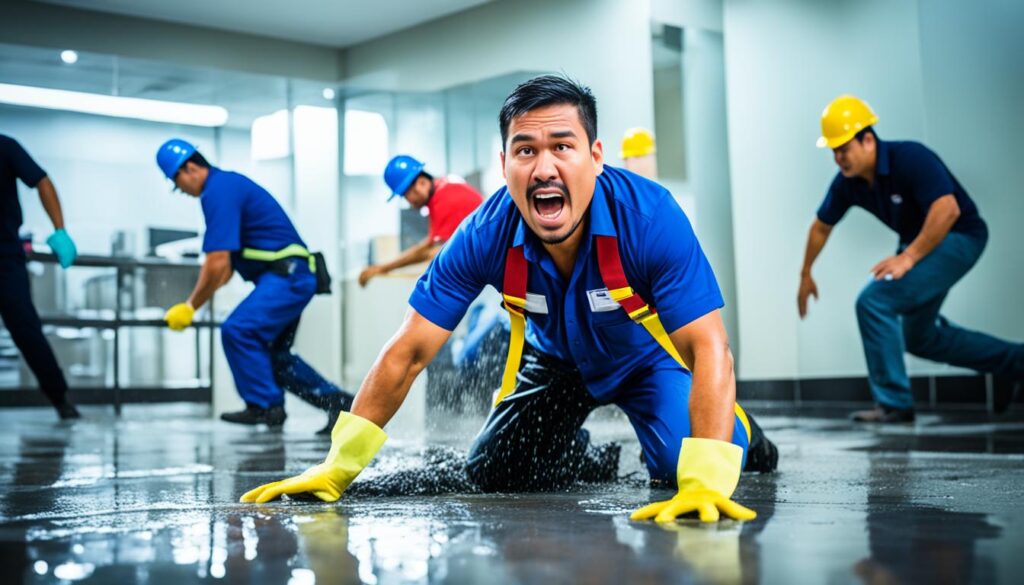
Implementing workplace safety protocols to address slips, trips, and falls, machinery and equipment accidents, and exposure to harmful substances is vital for the overall well-being of employees in any SME. By prioritizing workplace safety and adhering to these protocols, SMEs can create a safe and secure environment for their workforce.
Mandatory Safety Training: 8-Hour Safety and Health Seminar
As per workplace safety regulations in the Philippines, it is mandatory for small and medium enterprises (SMEs) to provide safety training to their employees. One of the key requirements is the 8-hour safety and health seminar, which plays a crucial role in ensuring a safe and healthy work environment.
This seminar covers a wide range of topics that are essential for employee well-being and workplace safety. It includes sessions on mandatory safety training, hazard identification and risk assessment, emergency response procedures, safety and health seminar, and compliance with workplace safety regulations.
During the seminar, employees learn about the importance of adhering to safety protocols, identifying potential hazards, and taking preventive measures to avoid accidents. They also gain knowledge about emergency response procedures, which are crucial in addressing any unforeseen events or emergencies in the workplace.
Compliance with workplace safety regulations is of utmost importance to SMEs. By conducting the 8-hour safety and health seminar, employers demonstrate their commitment to ensuring the safety and well-being of their employees. It also helps them avoid penalties and legal complications that may arise due to non-compliance with safety regulations.
“The 8-hour safety and health seminar is a valuable opportunity for SMEs to educate their employees on workplace safety measures and create a culture of safety in the organization.”
By investing in mandatory safety training, SMEs not only fulfill their legal obligations but also contribute to a safe and healthy working environment for their employees. This, in turn, enhances productivity, reduces workplace accidents, and boosts overall organizational performance.
To visually enhance this section, the following image can be added:
Once employees have completed the 8-hour safety and health seminar, they will be equipped with the knowledge and skills necessary to identify and mitigate potential workplace hazards, respond effectively to emergencies, and comply with workplace safety regulations. This seminar serves as a foundation for establishing a strong safety culture within SMEs, ensuring the well-being of employees and the longevity of the business.
Basic Safety Training: A Cornerstone for SME Safety Protocols
Basic safety training plays a crucial role in establishing and maintaining effective safety protocols within small and medium enterprises (SMEs). By equipping employees with the necessary knowledge and skills, comprehensive safety training programs ensure a safe and secure working environment.
Implementing workplace safety standards is essential for SMEs to protect their workforce and comply with regulatory requirements. Basic safety training courses provide employees with the understanding of safety protocols, hazard identification, and proactive measures to prevent accidents and injuries.
Through basic safety training, SMEs can instill a culture of safety within their organizations. Employees become aware of potential risks and develop the necessary skills to mitigate them, resulting in reduced workplace accidents and improved employee well-being.
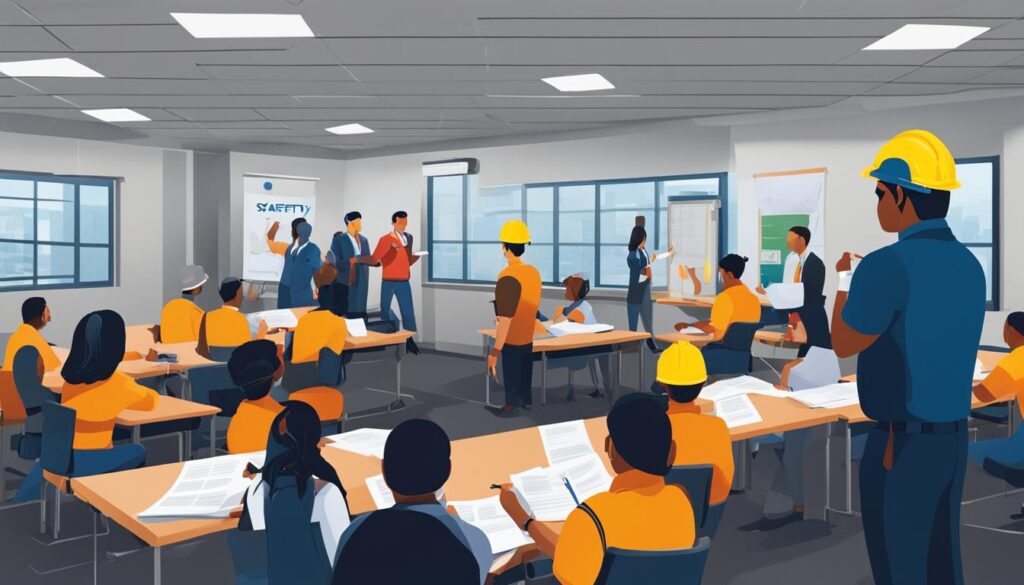
Moreover, basic safety training enhances the overall efficiency and productivity of SMEs. When employees feel safe and confident in their working environment, they are more motivated to perform their tasks effectively. This improves workplace morale, engagement, and ultimately leads to better business outcomes.
To ensure the successful implementation of safety protocols, SMEs should invest in comprehensive basic safety training programs tailored to their specific needs. By providing regular training sessions and refreshers, SMEs can continuously reinforce safety knowledge and promote a safety-conscious culture.
In summary, basic safety training serves as a cornerstone for SME safety protocols. By prioritizing employee well-being and implementing comprehensive safety training programs, SMEs can establish and maintain effective safety measures, creating a safer and more productive workplace.
Factors Influencing Occupational Safety in SMEs
Ensuring occupational safety in small and medium enterprises (SMEs) is crucial for protecting the well-being of employees and maintaining a productive work environment. To establish effective safety measures, SMEs need to consider several factors, including conducting comprehensive risk assessments, creating and implementing safety policies, and ensuring compliance with safety procedures.
Risk Assessment Steps
Risk assessment is a fundamental step in promoting occupational safety within SMEs. It involves identifying potential hazards and evaluating the likelihood and severity of associated risks. Conducting regular risk assessments enables SMEs to proactively identify areas of concern and implement appropriate control measures to mitigate potential accidents or injuries. SMEs should prioritize the following steps in their risk assessment process:
- Identify hazards: Thoroughly assess the workplace to identify potential hazards that could pose health or safety risks to employees.
- Evaluate risks: Determine the likelihood and severity of each identified hazard, considering factors such as frequency of exposure and potential consequences.
- Implement control measures: Develop and implement control measures that aim to eliminate or minimize the identified risks. This may include implementing engineering controls, administrative controls, or personal protective equipment (PPE).
- Regularly review and update: Continuously review and update the risk assessment process to account for changes in the workplace environment or operations.
Creating Effective Safety Policies
Establishing clear and comprehensive safety policies is essential for promoting occupational safety within SMEs. Safety policies provide guidelines and expectations for employees to follow, ensuring that everyone in the organization understands their roles and responsibilities in maintaining a safe work environment. When creating safety policies, SMEs should consider the following:
- Policy development: Involve employees in the development of safety policies to ensure buy-in and a sense of ownership.
- Clear communication: Clearly communicate safety policies to all employees, emphasizing the importance of compliance and the potential consequences of non-compliance.
- Training and education: Provide adequate training and education on safety policies to ensure employees have the necessary knowledge and skills to adhere to them.
- Regular review and updates: Continuously review and update safety policies to align with changing regulations, best practices, and lessons learned from incidents or near-misses.
Ensuring Compliance with Safety Procedures
Ensuring compliance with safety procedures is vital for maintaining a safe work environment. SMEs should implement effective methods to monitor, enforce, and reinforce safety procedures among employees. Some strategies to promote compliance include:
- Training and education: Provide regular safety training sessions for employees to reinforce the importance of safety procedures and best practices.
- Supervision and accountability: Assign supervisors or safety officers to monitor and enforce compliance with safety procedures, holding employees accountable for their actions.
- Rewards and recognition: Implement a system that rewards and recognizes employees who consistently demonstrate compliance with safety procedures and contribute to fostering a culture of safety.
- Continuous improvement: Regularly evaluate the effectiveness of safety procedures and gather feedback from employees to identify areas for improvement and ensure ongoing compliance.
| Benefits of Ensuring Occupational Safety in SMEs |
|---|
| Reduces the risk of work-related accidents and injuries |
| Enhances employee morale and job satisfaction |
| Increases productivity and efficiency |
| Reduces absenteeism and turnover rates |
| Improves the company’s reputation and credibility |
By effectively managing risk assessments, creating robust safety policies, and ensuring compliance with safety procedures, SMEs can prioritize occupational safety and protect their employees from potential harm. Investing in occupational safety not only safeguards the workforce but also enhances the overall success and sustainability of SMEs.
Developing and Implementing Effective Safety Guidelines
In order to maintain a safe work environment, it is crucial for businesses to develop and implement effective safety guidelines. These guidelines serve as a framework for workplace safety practices, protocols, and procedures.
Key elements of safety guidelines include:
- Risk Assessment: Conducting a thorough risk assessment allows businesses to identify and evaluate potential hazards in the workplace. By understanding the risks involved, appropriate safety measures can be implemented to mitigate them.
- Hazard Identification: Identifying workplace hazards is essential for preventing accidents and injuries. This involves recognizing potential sources of harm or danger and taking proactive steps to eliminate or minimize them.
- Emergency Response Plans: Having well-defined emergency response plans ensures that employees know how to respond effectively in the event of an emergency. This includes procedures for evacuation, first aid, and communication.
- Employee Training: Providing comprehensive training to employees on safety protocols and procedures is crucial for creating a culture of workplace safety. Training should cover topics such as hazard recognition, proper equipment usage, and emergency response.
Regularly reviewing and updating safety guidelines is essential to ensure their effectiveness. As workplace conditions evolve, new risks may arise, making it important to adapt safety protocols accordingly.
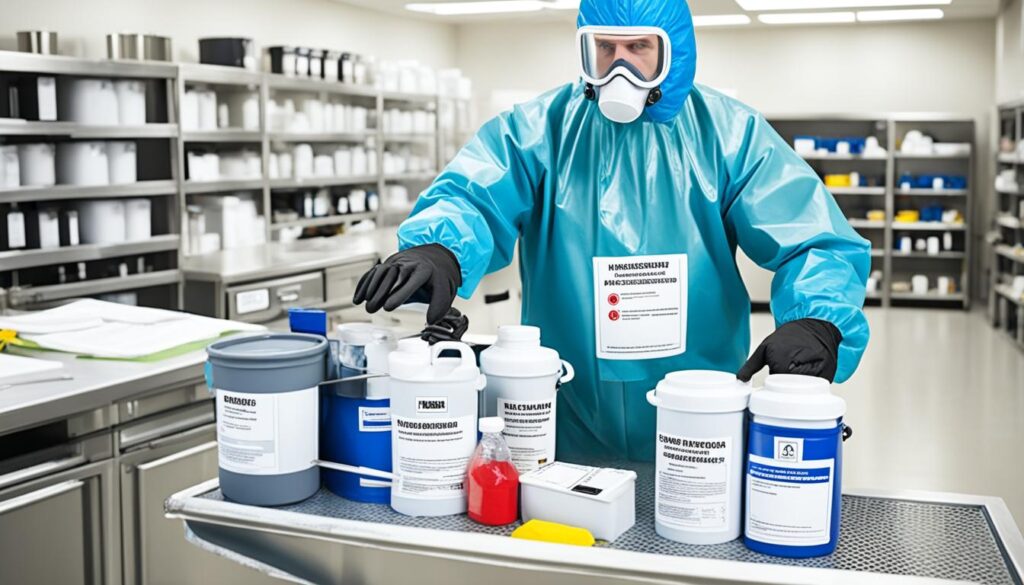
“Effective safety guidelines play a crucial role in safeguarding employees and creating a culture of workplace safety.”
By prioritizing safety guidelines, businesses can create a safe and secure work environment that promotes employee well-being and productivity.
| Key Benefits of Developing and Implementing Effective Safety Guidelines |
|---|
| Reduction in workplace accidents and injuries |
| Increased employee morale and satisfaction |
| Enhanced productivity and efficiency |
| Compliance with safety regulations and standards |
| Safeguarding business reputation |
Investment in Safety Training Courses and their ROI
Investing in safety training courses is a critical component for small and medium enterprises (SMEs) looking to prioritize workplace safety and enhance employee well-being. Not only does it contribute to a safer working environment, but it can also yield a significant return on investment (ROI) for businesses.
Benefits of BS OHSAS 18001 Certification
One valuable investment in safety training is obtaining the BS OHSAS 18001 certification. This internationally recognized certification demonstrates an organization’s commitment to implementing and maintaining effective occupational health and safety management systems. It provides SMEs with a competitive advantage, improved risk management, and enhanced compliance with regulatory requirements. Companies can build trust with clients, customers, and stakeholders by showcasing their dedication to the highest safety standards.
Customized Training for Unique Business Needs
Another way to maximize the investment in safety training is by opting for customized training programs tailored to the specific needs of the business. Generic training may not fully address the unique risks and challenges faced by SMEs. By customizing the training, companies can ensure that their workforce receives targeted instruction on the specific hazards and safety protocols relevant to their industry. This approach leads to better employee engagement, improved learning outcomes, and a more effective safety culture within the organization.
Improving Working Conditions and Staff Motivation
Investing in safety training also has a positive impact on working conditions and staff motivation. When employees feel safe in their work environment, they are more likely to be engaged, productive, and satisfied. Safety training equips employees with the knowledge and skills necessary to identify and mitigate workplace hazards, leading to reduced accidents and injuries. This not only improves morale but also minimizes absenteeism and turnover rates, resulting in cost savings for SMEs through increased productivity and retention of skilled workers.
By investing in safety training courses, obtaining certifications like BS OHSAS 18001, offering customized training programs, and prioritizing working conditions and staff motivation, SMEs can create a safer and more productive work environment. These investments not only protect the well-being of employees but also contribute to the long-term success and sustainability of the business.
| Investment in Safety Training | Return on Investment (ROI) |
|---|---|
| BS OHSAS 18001 Certification | Demonstrates commitment to safety, competitive advantage, improved risk management |
| Customized Training | Targeted instruction, better engagement, more effective safety culture |
| Improved Working Conditions | Increased employee motivation, productivity, and retention |
Strategies to Foster Employee Safety in the Work Environment
In order to prioritize employee safety, small and medium enterprises (SMEs) should implement key strategies that promote a safe work environment. These strategies encompass the provision of personal protective equipment (PPE), regular equipment maintenance, and the adoption of advancements in ergonomics and safe workspaces.
The Role of Personal Protective Equipment (PPE)
Personal protective equipment (PPE) plays a crucial role in safeguarding employees from workplace hazards. SMEs should ensure that their workers have access to appropriate PPE, such as safety helmets, goggles, gloves, and protective clothing. By providing and enforcing the use of PPE, SMEs can minimize the risk of injuries and maintain a high level of employee safety.
Importance of Regular Equipment Maintenance
Regular maintenance of equipment is essential to prevent malfunctions and accidents in the workplace. SMEs should establish and adhere to a comprehensive equipment maintenance schedule, ensuring that all machinery, tools, and devices are in proper working condition. By prioritizing equipment maintenance, SMEs can minimize the likelihood of accidents caused by faulty or malfunctioning equipment.
Advancements in Ergonomics and Safe Workspaces
Advancements in ergonomics and safe workspaces contribute to improved employee safety and well-being. SMEs can invest in ergonomic furniture and tools that promote proper posture, minimize strain, and reduce the risk of musculoskeletal disorders. Additionally, creating safe workspaces with well-lit areas, clear pathways, and proper ventilation can help prevent accidents and enhance employee productivity.
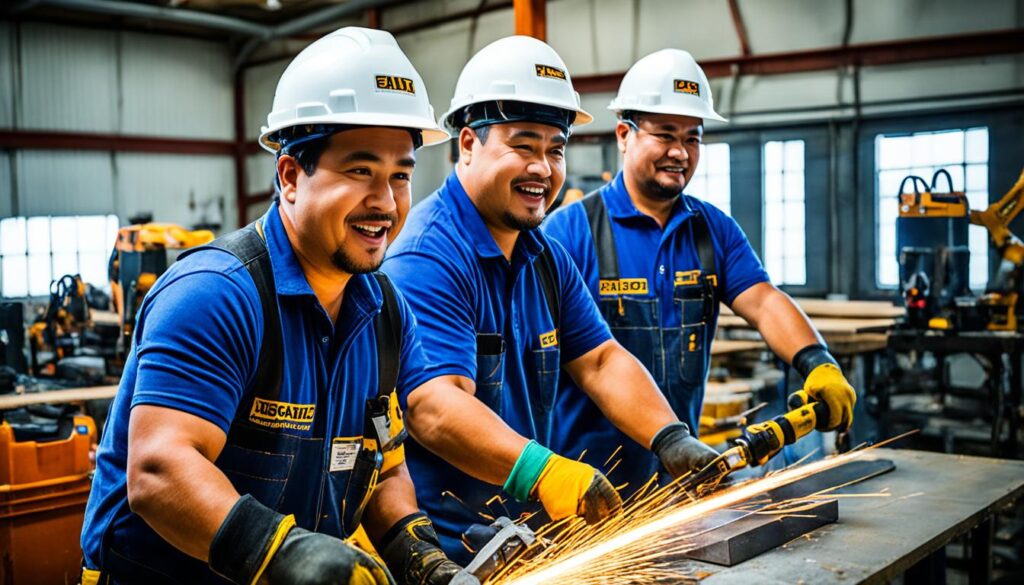
Incorporating these strategies into daily operations is crucial for SMEs to foster a safe work environment. By providing PPE, conducting regular equipment maintenance, and adopting ergonomics and safe workspace practices, SMEs can prioritize employee safety and create a culture of well-being within the organization.
Empowering SMEs through Occupational Safety and Health Advocacy
In order to foster a culture of workplace safety, small and medium enterprises (SMEs) can greatly benefit from occupational safety and health advocacy. Government agencies, non-profit organizations, and industry associations play a crucial role in promoting workplace safety initiatives and providing valuable resources for SMEs. By actively engaging in these advocacy efforts, SMEs can enhance their safety measures and protect their workforce.
Occupational safety and health advocacy initiatives focus on raising awareness about workplace safety, advocating for the implementation of safety protocols, and providing training and support to businesses. These initiatives aim to empower SMEs by equipping them with the knowledge and tools to identify and address potential hazards and risks in their work environment.
Government agencies, such as the Occupational Safety and Health Center (OSHC) in the Philippines, offer a range of programs and services to assist SMEs in their safety endeavors. They provide training courses, educational materials, and consultation services to help SMEs develop and implement effective safety practices. Non-profit organizations, such as the Philippine Chamber of Commerce and Industry (PCCI), also play a crucial role by organizing safety awareness campaigns, seminars, and workshops for SMEs.
Furthermore, industry associations, like the Safety Organization of the Philippines Inc. (SOPI), collaborate with SMEs to establish industry-specific safety guidelines and best practices. By actively participating in these associations, SMEs can gain access to valuable insights, networking opportunities, and the latest developments in workplace safety.
Occupational safety and health advocacy provides SMEs with the necessary support and guidance to navigate the complex landscape of workplace safety. By embracing these initiatives, SMEs can demonstrate their commitment to the well-being of their employees and create a safer work environment.
| Benefits of Occupational Safety and Health Advocacy for SMEs: |
|---|
| Access to valuable training courses and educational materials |
| Guidance in developing and implementing effective safety practices |
| Networking opportunities with other SMEs and industry experts |
| Increase in employee morale and engagement |
| Reduction in workplace accidents and injuries |
Conclusion
Ensuring workplace safety is crucial for small and medium enterprises (SMEs) in the Philippines. Basic safety training and the implementation of effective safety protocols play a vital role in protecting employee well-being and ensuring business sustainability.
By prioritizing workplace safety, SMEs not only create a secure environment for their workforce but also enhance productivity and reduce the risk of accidents and injuries. Providing employees with the necessary knowledge and skills through basic safety training courses equips them to identify potential hazards and take appropriate preventive measures.
We urge SMEs to take action and invest in creating a safe work environment. Implementing safety protocols, conducting regular risk assessments, and promoting the use of personal protective equipment (PPE) are some essential steps. Small changes, such as improving ergonomics and maintaining equipment, can go a long way in safeguarding employee well-being.
Protecting the welfare of employees is not just a moral obligation, but also a strategic decision. It fosters a positive work culture, enhances employee satisfaction and loyalty, and ultimately contributes to the success and growth of SMEs.
FAQ
What is basic safety training?
Basic safety training refers to the education and instruction provided to employees in order to equip them with the necessary knowledge and skills to ensure a safe working environment. It covers a range of topics, including workplace safety measures, protocols, guidelines, and procedures.
Why is workplace safety important?
Workplace safety is important to protect employees from accidents, injuries, and illnesses that may occur on the job. It also ensures compliance with safety regulations and promotes a positive work environment. Additionally, prioritizing workplace safety can enhance productivity, reduce absenteeism, and contribute to the overall success of the business.
What are safety measures and protocols?
Safety measures and protocols are guidelines and procedures put in place within an organization to minimize risks, hazards, and potential accidents. They define the necessary actions to be taken in various situations to ensure employee safety, such as the use of personal protective equipment, proper handling of equipment, and emergency response plans.
What are safety training courses?
Safety training courses are structured educational programs that provide employees with the knowledge and skills needed to maintain a safe working environment. These courses cover various topics, such as hazard identification, risk assessment, emergency preparedness, and specific safety protocols relevant to the industry or job role.
How prevalent are workplace accidents in the Philippines?
Workplace accidents are unfortunately quite prevalent in the Philippines, particularly in industries such as construction, manufacturing, agriculture, and mining. These industries have unique risks and hazards that can lead to accidents if proper safety measures and protocols are not implemented.
What are the risks associated with the construction industry?
The construction industry involves many hazards, including falls from heights, being struck by falling objects, and accidents involving heavy machinery. It is essential for workers to undergo adequate safety training to mitigate these risks and ensure their safety on construction sites.
What are the hazards in the manufacturing and agriculture sectors?
The manufacturing sector often presents hazards related to operating machinery, exposure to chemicals, and physical strain from repetitive tasks. In agriculture, hazards can include working with heavy machinery, exposure to pesticides, and risks associated with working in outdoor environments.
What safety concerns exist in the mining industry?
The mining industry has specific safety concerns due to the nature of the work, such as cave-ins, explosions, and exposure to hazardous substances. It is crucial for mining employees to receive proper safety training and adhere to safety protocols to minimize the risk of accidents.
How can slips, trips, and falls be prevented in the workplace?
Preventing slips, trips, and falls requires implementing safety measures such as maintaining clear walkways, using proper signage, ensuring proper lighting, and encouraging employees to wear appropriate footwear. Regular inspections and prompt repairs of any potential hazards are also essential.
What are machinery and equipment accidents, and how can they be prevented?
Machinery and equipment accidents can involve improper use, lack of maintenance, or operating machinery without adequate training. Preventive measures include comprehensive employee training, regular maintenance and inspections of equipment, and the use of safety guards and protective devices.
How can exposure to harmful substances be controlled?
Proper controls can be put in place to minimize the exposure of employees to harmful substances. This includes providing personal protective equipment, ensuring proper ventilation and exhaust systems, implementing safe handling procedures, and providing training on hazardous substance management.
What is the 8-hour safety and health seminar?
The 8-hour safety and health seminar is a mandatory training program required by workplace safety regulations in the Philippines. It covers various topics, such as occupational hazards, emergency preparedness, and safety protocols. It is important for SMEs to ensure their employees attend and complete this seminar to comply with safety regulations.
What role does basic safety training play in SME safety protocols?
Basic safety training is a cornerstone for SME safety protocols as it equips employees with the necessary knowledge and skills to maintain a safe working environment. It lays the foundation for implementing effective safety measures, protocols, and guidelines within the organization, ultimately protecting employees and promoting a positive safety culture.
How can SMEs strengthen their occupational safety measures?
SMEs can strengthen their occupational safety measures by conducting regular risk assessments, creating effective safety policies and procedures, and ensuring compliance with safety regulations. Engaging employees in safety initiatives, providing training, and regular safety drills are also important for maintaining a safe work environment.
What are the key elements of effective safety guidelines?
Effective safety guidelines include risk assessment procedures, hazard identification protocols, emergency response plans, and employee training programs. Regular reviews and updates to safety guidelines are crucial to ensure their ongoing effectiveness in addressing potential risks and hazards.
What are the benefits of investing in safety training courses?
Investing in safety training courses can bring several benefits to SMEs. It can lead to improved compliance with safety regulations, reduced accidents and injuries, enhanced employee productivity and motivation, and lower insurance costs. Obtaining certifications such as BS OHSAS 18001 can further demonstrate a commitment to workplace safety.
How can SMEs foster employee safety in the work environment?
SMEs can foster employee safety by providing personal protective equipment, conducting regular equipment maintenance, and implementing advancements in ergonomics and safe workspaces. Encouraging a safety-first mindset, promoting open communication, and providing ongoing safety training and education are also instrumental in creating a safe workplace.
How can SMEs actively engage in occupational safety and health advocacy?
SMEs can actively engage in occupational safety and health advocacy by staying informed about relevant safety initiatives and resources provided by government agencies, non-profit organizations, and industry associations. They can participate in safety training programs, conferences, and seminars, and collaborate with other SMEs to share best practices and knowledge to enhance their safety measures.
Why should SMEs prioritize workplace safety?
Prioritizing workplace safety is crucial for SMEs to ensure the well-being of their employees and to protect the sustainability of their business. Safety training, implementing effective safety protocols, and complying with safety regulations not only minimize the risk of accidents and injuries but also contribute to a positive work culture, employee morale, and overall business success.
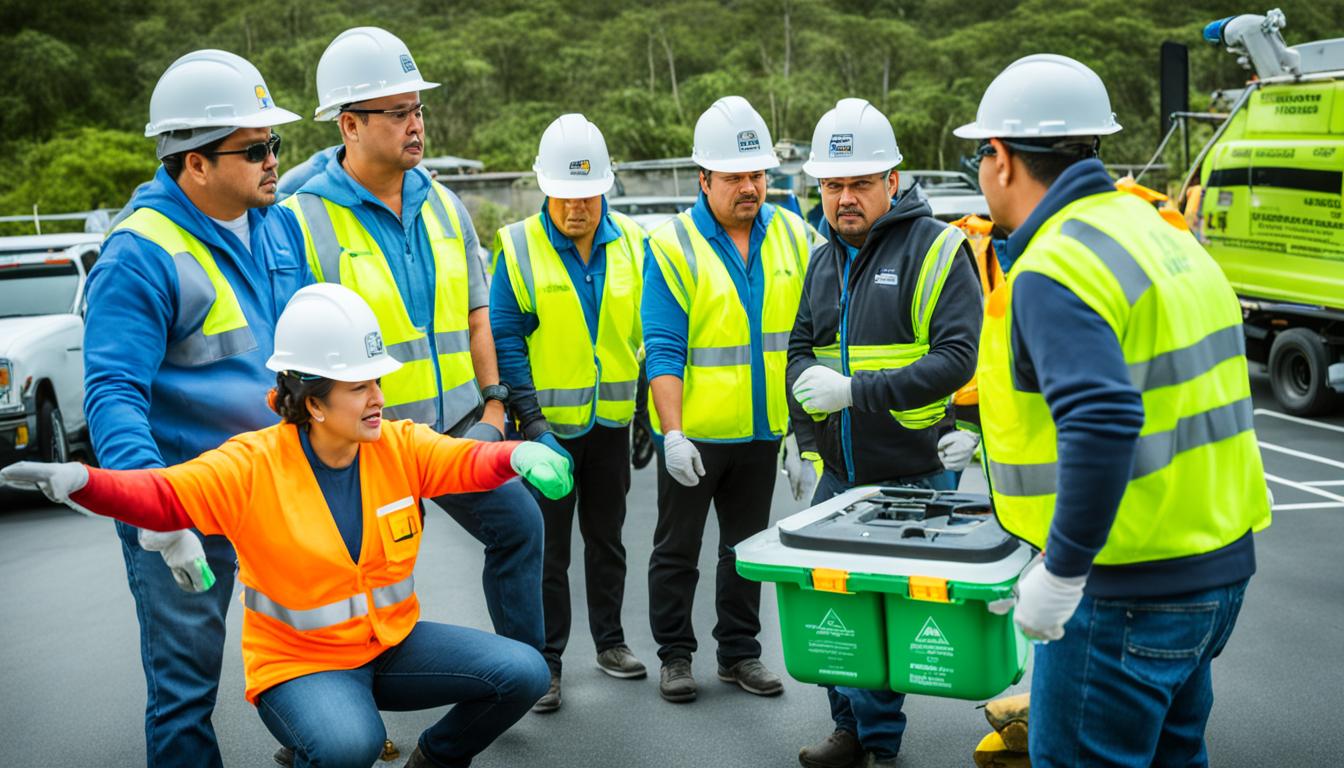
Leave a Reply